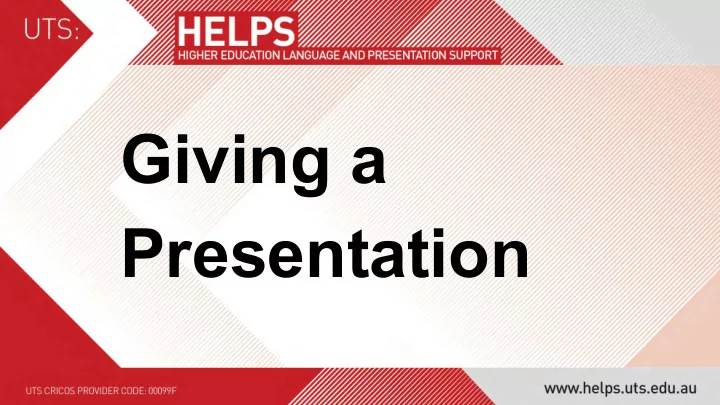

Giving a Presentation
DAVID SOTIR - ADVISOR Location: CB01.03.08 Telephone: 9514 9733 Email: helps@uts.edu.au Website: uts.edu.au/current-students/support/helps/about-helps
What can I gain from this session? • How to overcome nervousness in public speaking • How to prepare for a seminar presentation
Overcoming nervousness Get to know your classmates (audience) • Sit next to someone you find reassuring • Eye contact • Write down what you want to say • Know what you are talking about (confidence) • Take small steps • Don’t forget to breathe •
Oral presentation assessments • Individual or group presentation • Standalone or part of an assessment
Why am I assessed? • Work readiness • Employability skill (presentation and team work)
Sample assessments • 48230 Engineering Communication • 21878 Organisational Dialogue: Theory & Practice
Preparing for a seminar presentation • Purpose (to inform/persuade, topic, requirements) • Planning (subject matter, organisation) • Considerations • Context (formal/informal, appropriateness) • Audience (who, how, what) • Venue (where, what, how) • Research • Structure • Resources (equipment, visual aids) • Time management • Practice
Structure • Overview • Introduction • Body • Conclusion • Q&A
Delivering a presentation • Verbal communication • Chunking and pausing • Word stress • Intonation • Speed • Clarity • Non-verbal communication • Body language • Posture • Hands • Eye contact
Using visual aids Learn how to KISS.
Common visual aids • PowerPoint • Prezi • Videos • Images • Posters • Real objects
Visual aids • First of all, ask yourself: is it necessary to • And don’t go crazy with the animation and use visual aids? Perhaps all you need is sound effects. They can be very distracting you. If you do use visual aids such as and annoying. PowerPoint, remember that you are the star, • Proofread your slides. It doesn’t reflect very not the PowerPoint slides. You want the well on you professionally if their are spilling audience’s attention on you and what you errors every wear. have to say, not the slides. • While presenting, don’t stand in front of the • Make sure you do not have too much text on screen or your shadow will block the your slides. The audience is there to listen to projection. you; if they end up reading all the • And don’t talk to the screen. Face the information on the slides, they won’t need to audience at all times. You might want to pay any attention to you. refer to something on a slide from time to • Be careful with the use of appropriate fonts time, but do so briefly. and colours, for obvious reasons. • Lastly, don’t read from your notes. Speak naturally.
Visual aids • Necessary? • Fonts and colours? • Proofread? • Blocking? • Talking to the visual? • Too much info? • Animation and sound effects? • Simply reading?
Sample Prezi http://prezi.com/6pqw4no3uvlr/?utm_campaign=share&utm_medium=copy&rc=ex0share
Group presentations • Allocating sections to members • Introducing team members • Transitioning from one to the other • Positioning • Paying attention to the speaker • Practice
Handling Q&A • Anticipate the questions • Thank the questioner – it’s a compliment! • Ensure everyone has heard the question • Seek clarification from the questioner • Seek information from the audience (and promote discussion) • Deal with several people trying to speak at once • Be honest if you don’t know the answer
Developing your arguments • Make a statement, then list the supporting points OR • Introduce an opposing argument, then explain why it’s not valid
Creating more impact: alternative openings • Ask the audience a question • Ask the audience to do something
Creating more impact: word stress • The situation isn’t going to improve. • The situation is NOT going to improve.
Creating more impact: rhetorical question • UTS is well-known for many things. We are one of the best universities in Ultimo. We have the beautiful and iconic Tower Building. But do you know what else we have? • The brightest students in the country.
Creating more impact: adverbs of degree • The long-term effects are worrying. • The long-term effects are extremely worrying. • The PM is concerned about his security. • The PM is increasingly concerned about his security. • With more funding, the death rates can be reduced. • With more funding, the death rates can be dramatically reduced.
Creating more impact: strategic repetition • The implications are very serious indeed. • The implications are very, very serious indeed. • Many animals are forced out of their natural habitat. • Many, many animals are forced out of their natural habitat.
Creating more impact: representing numbers and data In 2013, there were 37381 students in UTS: 10887 were enrolled in UTS Business School; 3494 in Faculty of Design, Architecture and Building; 4957 in Faculty of Arts and Social Sciences; 7785 in Faculty of Engineering and Information Technology; 2743 in Faculty of Law; 3310 in Faculty of Health; 3310 in Faculty of Science; and 895 in others. Using tables and figures
Creating more impact: relating to numbers and data According to UNICEF (2014), extreme poverty claims the lives of 10 million, 950 thousand children annually. According to UNICEF (2014), extreme poverty claims the lives of 10 million, 950 thousand children annually. Just think about that. It works out to be 30,000 children every day, or 1250 every hour.
Cancer Council Australia (2013) claims that 1 in 2 Australian men and 1 in 3 Australian women will be diagnosed with cancer by the age of 85. Cancer Council Australia (2013) claims that 1 in 2 Australian men and 1 in 3 Australian women will be diagnosed with cancer by the age of 85. Look around you. That’s 50% of the men here, and 30% of the women. It’s a very sobering thought.
Recommend
More recommend